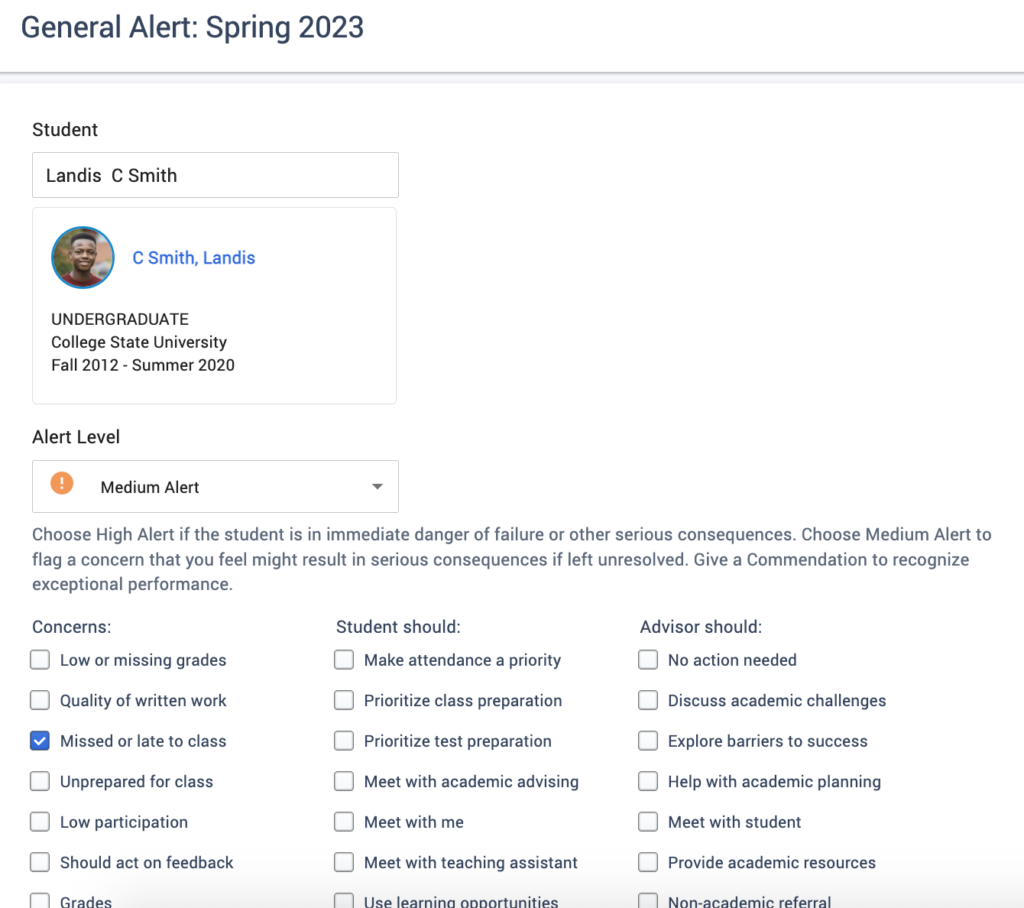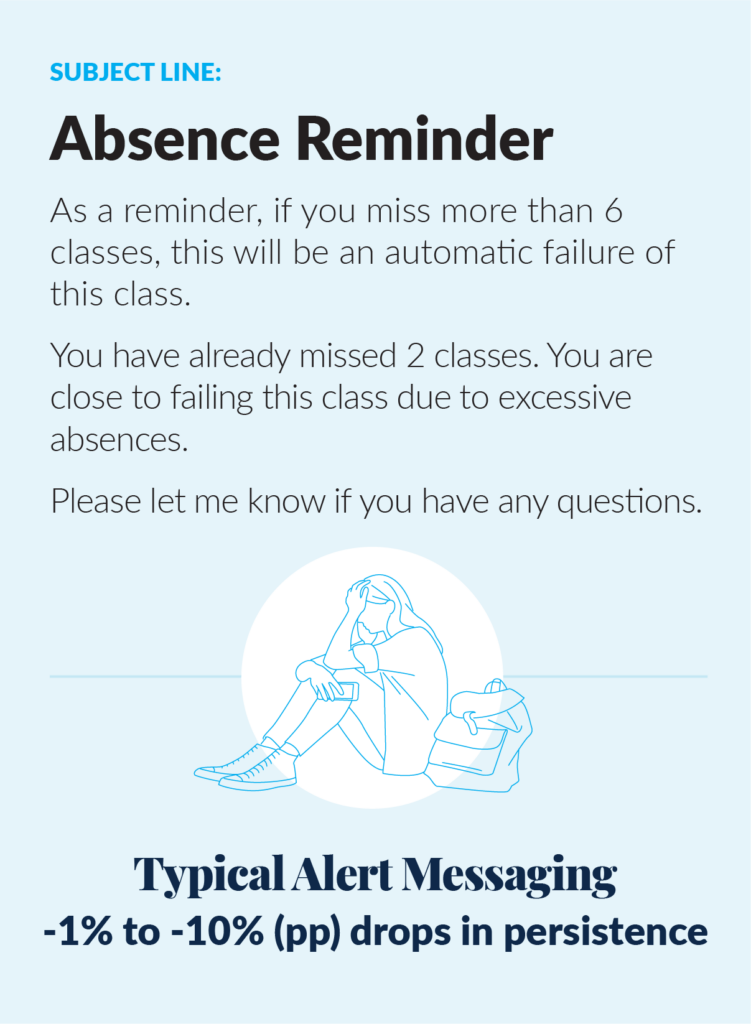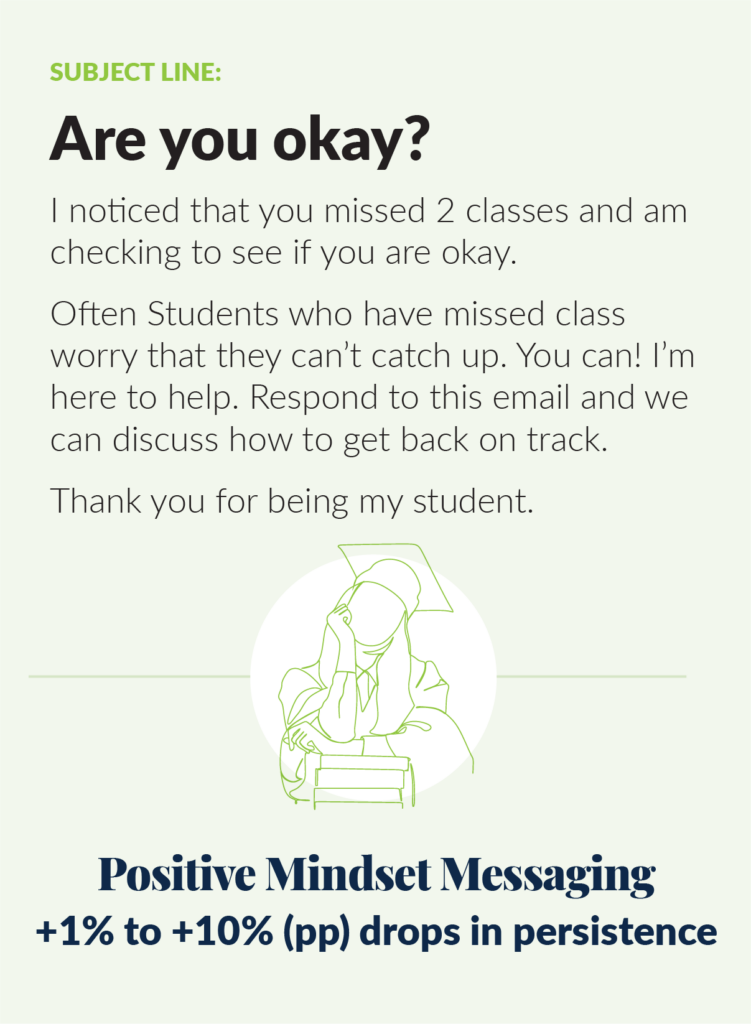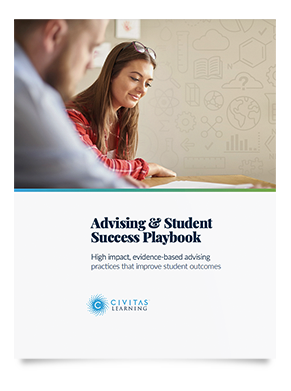
Is Your Early Alert System Doing More Harm Than Good?
Share this Post
As we learn more about how students respond to early alert systems in higher education, it’s becoming clear that being intentional about designing and implementing early alerts is very important.
Recent research from New America indicates that poorly designed early alert interventions can work against your student success efforts.
When Do Early Alerts Harm Student Success Efforts?
A growing body of research indicates that effective early alerts must be raised and responded to intentionally and rooted in understanding the whole student experience. A poorly designed early alerts intervention process can result in several outcomes that cause more harm than good to your students and institution, including:
- Inadvertently discouraging student engagement and sense of belonging
- Overwhelming staff with too many weak alerts based only on academic performance rather than observed changes in student behavior
- Setting staff up to fail to respond quickly to alerts raised during peak times, such as advising and registration
- Perpetuating implicit bias and systemic barriers to success for students of color and other underserved student populations
These unintended consequences can be limited by using student success analytics to gain a broader view of student risk factors and developing solid policies and training protocols for faculty and staff who raise and respond to alerts.
Explore Advising Analytics & Workflow
3 Emerging Practices for Using Early Alert Systems in Higher Education
The ability to identify early on that a student is experiencing difficulty helps higher education institutions proactively support students. When used in the context of other student success analytics, early alert systems can help faculty quickly communicate concerns that might impact a student’s academic success. Responding to faculty observations, advisors are better equipped to provide just-in-time support to struggling students.
Here are three emerging practices Civitas Learning partners use to develop and execute early alert interventions more effectively:
- Empower faculty to focus on shifts in student behavior instead of simply reporting academic performance concerns.
- Train staff to respond to alerts in the context of all known student information.
- Carefully craft alert messages and outreach methods according to the needs of each student.
Empower faculty to focus on shifts in student behavior instead of simply reporting academic performance concerns.
Faculty have an important vantage point to observe student behavior and watch for signs that students may need additional support. However they need the training and a user-friendly connected system to put their observations into a valuable and actionable context for the staff partners who will intervene when they raise an alert.
When faculty note changes in student behavior—such as flagging energy or engagement, a change in attendance or quality of work submitted, or a new behavior that hints at issues of physical or emotional well-being—student success staff have more context to factor into their decision-making about appropriate intervention methods and messaging.
Administrators should carefully consider how and when faculty are asked to use alerts to provide information about student progress. While many institutions utilize a regular schedule of “checkpoint” alerts (e.g., early attendance reports, mid-semester progress, etc.), overuse of checkpoints may result in blanket alert-raising that inundates advisors with too many alerts and little actionable information to follow up on. Using a system to assess LMS engagement relative to peers and automatically surfaces signals to advisors based on that behavior can alleviate administrative tasks and provide actionable context for advisors.
Train staff to respond to alerts in the context of all known student information.
Staff who receive and respond to alerts must consider all the information they know about a student to respond accurately and authentically.
By placing them in the context of other success metrics, Civitas Learning partners can better determine which faculty-raised alerts need immediate attention. Access to a fuller picture of the student’s situation – such as LMS engagement, in-progress grades, persistence and completion predictions, advising notes, and previous alerts – allows staff to contextualize alerts and pursue effective engagement with their students.
Considering all available data when reviewing and developing an appropriate response to an alert helps advisors respond with greater care and authenticity. One partner institution, Lorain County Community College, found that consistent monitoring of student data within the Civitas Learning platform enabled advisors to see the subtle changes in student progress before an alert was even raised.

Carefully craft alert messages and outreach methods according to the needs of each student
One of the most damaging outcomes of a poorly developed alert intervention is outreach which has a negative effect. An analysis of Civitas Learning partner institutions using automated flags like alerts, kudos, and attendance, found automated or transactional messages resulted in a -1 to -10 percentage point drop in persistence compared to positive growth mindset messaging, resulting in a 1 to 10 percentage point lift in persistence.
When a student receives a message telling them they’re not doing well in class, the student may interpret it as a sign that they’re not up to the task of college and don’t belong. Unfortunately, research shows that the likelihood of this scenario is even greater for a student of color or a student representing another underserved student group.


Alert interventions that consider the student’s identity, context, and available information help those reaching out to support the student prioritize their efforts. It also helps them to craft appropriate messages and use communication channels more likely to resonate with the student receiving the outreach. Staff responding to alerts benefit from training in this practice, and supervisors can help by developing a guide of sample communications for staff to use in outreach efforts.
Advisors need easy access to comprehensive student information to contextualize alerts and personalize outreach. This more precise understanding of a student’s situation enables advisors to first address those with the most pressing need and craft more resonant outreach. It’s helpful to develop an early alert intervention process that considers this when determining who will respond to alerts and how alert responses will take place during other peak times for those staff members.
Develop Your Early Alerts Intervention Process with Intentionality, Context, and Training
While it’s tempting to think of early alerts as the magic pill that can solve your institution’s retention and completion challenges, it’s much more effective to consider early alert systems as one tool in the toolbox of student success strategies. And it’s essential to consider the pitfalls of a poorly designed alert process.
Institutions that consider early alert intervention in the context of student success analytics and provide adequate training for faculty and staff who raise and respond to alerts can avoid the potentially damaging outcomes of a poorly developed early alert program.




